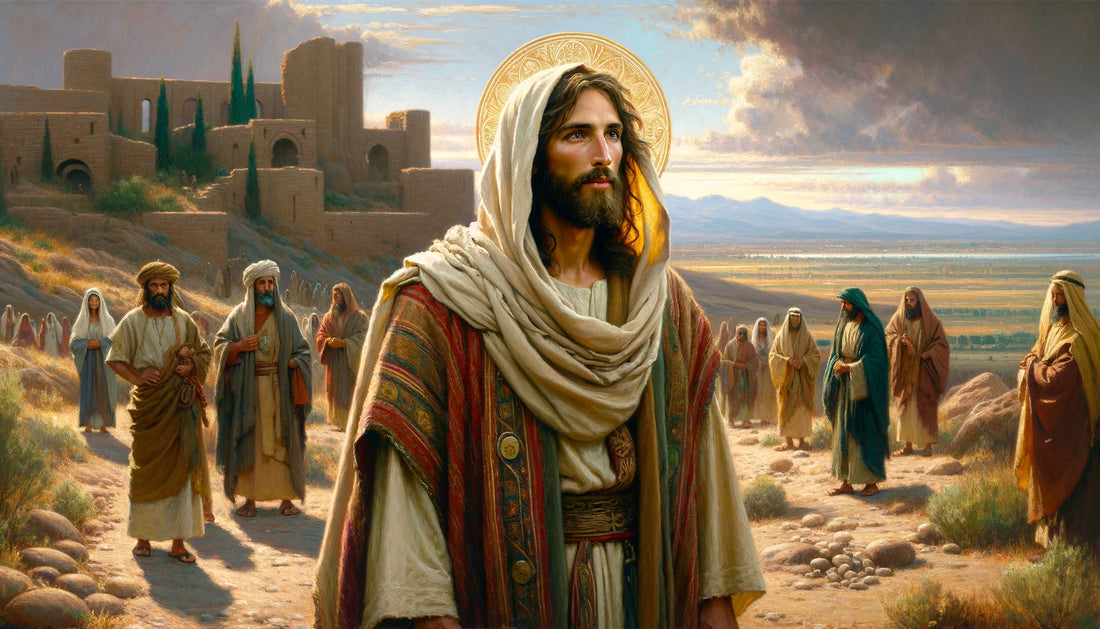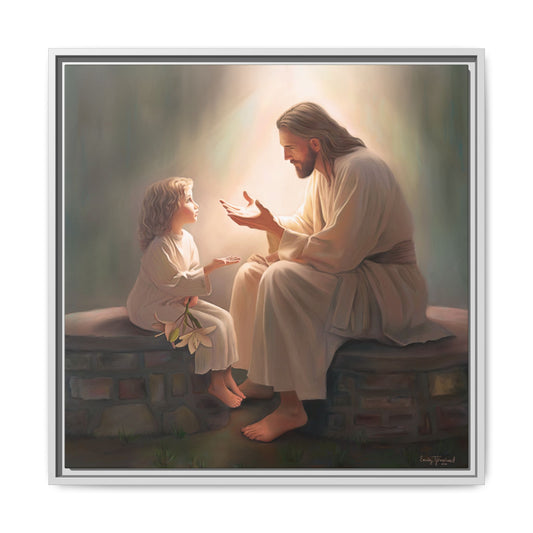
As we navigate the intricate web of historical and cultural influences that have shaped the portrayal of Jesus, we are faced with the compelling question of accuracy in painting his likeness. The image of Jesus has evolved through the centuries, reflecting the diverse perspectives and artistic interpretations that have colored our perception of the Son of God. However, in our quest to unravel the complexities surrounding his visual representation, it becomes evident that the significance of accurate paintings of Jesus extends far beyond mere artistic endeavor. Join us as we peel back the layers of historical context, cultural implications, and theological reflections to uncover the profound importance of portraying Jesus with authenticity and respect.
Key Takeaways
- The historical Jesus likely had the brown eyes and skin of other first-century Jews from Galilee.
- There are no known images of Jesus from his lifetime.
- Early Christian artists used syncretism to depict Jesus, combining visual formats from other cultures.
- The depiction of a white Jesus in different parts of the world was a result of European colonization and cultural influence.

The significance of accurate portrayals of Jesus
Accurate
portrayals of Jesus hold significant cultural and historical importance, shaping our understanding of religious iconography and its impact on diverse communities. The accurate portrayal of Jesus is crucial in conveying the true essence of his teachings and life, allowing individuals to connect with his message in a profound and authentic manner. It serves as a representation of truth and integrity, providing a meaningful and genuine reflection of Jesus' identity, which is essential for fostering a deep spiritual connection and understanding. An accurate portrayal of Jesus also plays a pivotal role in promoting inclusivity and diversity within religious communities. By depicting Jesus in a manner that aligns with historical and cultural realities, we honor the diverse backgrounds and ethnicities of individuals worldwide. This representation fosters a sense of belonging and acceptance, acknowledging the multifaceted nature of humanity and spirituality. Furthermore, an accurate portrayal of
Jesus serves as a powerful tool for dispelling misconceptions and prejudices, promoting empathy, and understanding among different groups. It enables individuals to embrace the universal message of love, compassion, and unity that Jesus embodies, transcending barriers and fostering a sense of shared humanity. Therefore, the significance of accurate portrayals of Jesus can't be overstated in promoting harmony, understanding, and reverence for diverse cultural and historical perspectives.

Historical Context of Jesus Portraits
We will explore the historical context of Jesus portraits, aiming to understand the cultural and artistic conventions prevalent during the 1st century. Furthermore, an examination of ancient depictions of
Jesus found in early Christian art will shed light on the evolution of his portrayal. Additionally, we'll explore the influence of biblical accounts on the depiction of Jesus, offering insights into the historical context that shaped these iconic representations.
Understanding the cultural and artistic conventions of the time (1st century)
The cultural and artistic conventions of the 1st century significantly influenced the historical context of Jesus' portraits.
-
Judean Aesthetics: Jesus likely had brown or black hair, honey or olive-brown skin, and brown eyes, in line with first-century Judean features.
-
Syncretism in Art: Early Christian artists used syncretism, blending visual formats from various cultures, to create depictions of Jesus, such as the popular image of Christ as the Good Shepherd.
-
Miraculous Images: The Mandylion and the volto santo are famous miraculous images reinforcing the standardized portrayal of a bearded Christ with shoulder-length, dark hair.

Understanding these conventions helps us appreciate the historical accuracy and cultural significance of Jesus' portrayals in 1st-century art.
Examination of ancient depictions of Jesus found in early Christian art
Early Christian
art provides valuable insights into the ancient depictions of Jesus and their historical context. The paintings of
Jesus Christ found in early Christian art offer a glimpse into how the figure of Jesus was initially portrayed. These depictions often reflect the cultural and artistic conventions of the time, shedding light on the perception of Jesus in the early Christian community. These early artworks reveal the evolving interpretation of Jesus' physical appearance and the symbolism associated with his depiction. The examination of ancient paintings of
Jesus provides a fascinating window into the early Christian understanding of Jesus Christ and the artistic techniques employed to convey his likeness. Understanding the historical context of these depictions enriches our appreciation of the significance of Jesus' portrayal in early Christian art.
Biblical accounts and their influence on the portrayal of Jesus
Biblical accounts of Jesus' life and teachings played a pivotal role in shaping the portrayal of Jesus in early Christian art, providing insights into the historical context of his portraits. This influence is evident through:
- Descriptive Accounts: Biblical descriptions of Jesus' appearance, such as his long hair, beard, and compassionate gaze, have influenced artists' renderings of his portrait.
- Symbolic Representations: The biblical imagery of Jesus as the Good Shepherd or the Son of God has inspired artists to depict him in specific roles and poses, conveying spiritual and moral messages.
- Cultural Context: The cultural and historical settings described in the Bible, such as the attire and customs of the people during Jesus' time, have influenced how artists have portrayed Jesus in his earthly life.
These biblical influences have deeply shaped the
image of Jesus in art, reflecting the desire to convey the essence of his teachings and divine nature through visual representation.

Exploring the Image of Jesus in the Bible
Let's start exploring the image of
Jesus in the Bible by analyzing the biblical descriptions and references to his appearance. We can learn more about the Gospel of John to gain insights into Jesus' physical features and debunk misconceptions and popular cultural depictions of him. This will provide a deeper understanding of how
Jesus is portrayed in the Bible and how to reconcile it with historical and artistic representations.
Analyzing the biblical descriptions and references to Jesus' appearance
Exploring the Image of Jesus in the Bible reveals a complex interplay of literary descriptions and historical context that shape our understanding of his physical appearance. When analyzing the biblical references to Jesus' appearance, we encounter a thought-provoking journey through the following:
- Sparse Descriptions: The biblical accounts provide limited details about Jesus' physical features before his death, leaving room for interpretation and conjecture.
- Symbolic Imagery: The Old Testament references and the Transfiguration account depict Jesus in majestic and glorified forms, offering symbolic rather than literal descriptions of his appearance.
- Heavenly Depictions: The Book of Revelation describes Jesus in a heavenly, transcendent form, emphasizing his spiritual significance rather than his earthly appearance.
This exploration underscores the enigmatic nature of biblical descriptions of Jesus' appearance, inviting us to consider the deeper symbolic and spiritual meanings beyond physical attributes.

Investigating the Gospel of John and its insights into Jesus' physical features
We've examined the sparse descriptions of
Jesus' physical features in biblical accounts, now turning our focus to the insights offered by the Gospel of John regarding Jesus' appearance. The Gospel of John provides a unique perspective on Jesus' physical features, emphasizing his divine nature and spiritual significance rather than his outward appearance. John's portrayal of Jesus focuses on his teachings, miracles, and the profound impact he'd on people's lives. While the Gospel of John doesn't offer specific details about Jesus' physical appearance, it presents a vivid portrait of his character, emphasizing his compassion, wisdom, and love for humanity. Rather than focusing on his physical features, John's gospel invites us to contemplate the deeper essence of Jesus' being and his transformative influence on the world.
Debunking misconceptions and popular cultural depictions of Jesus
Debunking popular cultural depictions of Jesus in the Bible reveals the need to reexamine the historical and cultural influences shaping our understanding of his image. When we debunk misconceptions and popular cultural depictions of Jesus, we invite a more accurate painting of Jesus that aligns with historical and biblical evidence. This process allows us to challenge and break free from stereotypes and biases that may have influenced our perception of Christ's appearance. By debunking these misconceptions, we can create a more authentic and inclusive representation of Jesus, reflecting the diverse and rich tapestry of humanity. As we strive for accuracy in portraying Jesus, we honor his true likeness and embrace the beauty of diversity in our depictions of the Son of God.

The Role of Science and Historical Research in Accurate Portrayals
As we explore the role of science and historical research in accurate portrayals of Jesus, it becomes imperative to examine the scientific and archaeological evidence on historical appearances. The influence of facial reconstruction techniques on our understanding of Jesus' looks has been profound, shedding light on the likely physical features of the historical Jesus. Additionally, insights from historical research have significantly impacted contemporary depictions, prompting a reassessment of traditional representations in light of new findings.
Examining scientific and archaeological evidence on historical appearances
Studying scientific and archaeological evidence is crucial in understanding the historical appearances of Jesus and the role of science and historical research in creating accurate portrayals. When examining the historical evidence, we consider:
- The analysis of ancient skeletal remains and DNA to understand the physical traits of people from Jesus' time.
- The study of first-century Jewish burial practices and customs to gain insight into hairstyles, facial hair, and clothing.
- The investigation of historical documents and artifacts to uncover visual representations or written descriptions of individuals from Jesus' era.
The influence of facial reconstruction techniques on our understanding of Jesus' looks
The examination of historical appearances of Jesus has led us to consider the influence of facial reconstruction techniques on our understanding of his looks. These techniques have the potential to provide a more accurate portrayal of Christ's face based on scientific and historical research. By analyzing skeletal remains and utilizing forensic anthropology, experts can reconstruct an approximation of Jesus' facial features. This method offers a more objective approach to depicting Jesus, moving away from the subjective interpretations influenced by cultural and artistic trends. Below is a table summarizing the impact of facial reconstruction techniques on our understanding of Jesus' looks:
| Impact of Facial Reconstruction Techniques on Understanding Jesus' Looks |
| Objective portrayal of Jesus' facial features |
| Reduction of subjective cultural and artistic influences |
| Integration of scientific and historical research |
| Potential for a more accurate representation of Christ's face |

Insights from historical research and its impact on contemporary depictions
Our examination of historical research reveals the critical role of science and historical analysis in shaping contemporary
depictions of Jesus. Historical research provides valuable insights that impact how we portray Jesus today.
- Historical accuracy: Through extensive research, we gain a deeper understanding of the historical context, enabling us to create more accurate representations of Jesus.
- Cultural impact: By learning more from historical records, we can better comprehend the cultural influences that have shaped depictions of Jesus over time, allowing us to create more inclusive and culturally sensitive portrayals.
- Challenging stereotypes: Historical research challenges traditional stereotypes and biases, empowering us to present Jesus in ways that reflect diverse perspectives and promote understanding and empathy.
The Artistic Interpretation of Jesus
As we explore the artistic interpretation of Jesus, we uncover the profound impact artists have had on shaping our visual understanding of the divine figure. From the Renaissance to modern times, famous portraits of
Jesus have left a lasting impression on religious art and the portrayal of Christ's divinity. Through various artistic styles and techniques, artists have sought to convey the essence of Jesus, providing us with a rich tapestry of visual representations to contemplate.

The role of artists in depicting Jesus throughout history
Artists have played a significant role in shaping the diverse depictions of Jesus throughout history. Throughout the ages, artists have contributed to the visualization of Jesus through their creative interpretations, reflecting cultural and societal influences.
-
Early Christian Artists: They used syncretism to blend various cultural visual formats in their depictions of Jesus, creating a new, unified representation.
-
European Artists and Colonization: European artists influenced the global perception of Jesus, portraying him with light-skinned features that were spread through trade and colonization.
-
Impact on Racism and White Supremacy: The portrayal of Jesus as a white European man has been linked to the perpetuation of racist ideologies, contributing to the notion of white supremacy.
The work of artists hasn't only reflected the historical contexts in which they lived but also influenced societal perceptions of Jesus, making their role crucial in shaping the visual legacy of Jesus throughout history.
Famous Jesus portraits and their impact on religious art
The depiction of Jesus in famous portraits has had a profound impact on religious art throughout history. These iconic images of Jesus, such as Warner Sallman's 'Head of Christ', have influenced the artistic representation of Jesus in diverse cultural contexts. The artistic interpretation of Jesus in portraits has shaped the collective imagination of his physical features, often reflecting the cultural and racial perspectives of the artists. These portraits play a significant role in shaping the visual identity of Jesus and have contributed to the perpetuation of certain racial and cultural narratives. The artistic choices made in these portraits have left a lasting impact on religious art, influencing the way Jesus is perceived and understood by different communities around the world.

Examining different artistic styles and their impact on conveying Jesus' divinity
Famous
Jesus portraits have left a lasting impact on religious art, shaping the collective imagination of his physical features. Now, examining different artistic styles and their impact on conveying Jesus' divinity reveals the dynamic nature of his visual representation. Realism: Detailed and lifelike representations of Jesus, aiming to depict him as a relatable figure. Symbolism: The use of symbols and allegorical elements to convey Jesus' divine nature and spiritual significance in a metaphorical manner. Abstract Art: Exploration of Jesus' divinity through non-representational forms, evoking emotions and spiritual contemplation through color, texture, and composition. These diverse artistic styles offer unique perspectives on Jesus, enriching the visual portrayal of his divinity and inviting deeper contemplation of his spiritual significance.
Theological Reflections on Jesus Portraits
As we reflect on the theological significance of Jesus portraits, we're reminded of the profound impact these images have on our faith and spirituality. Jesus portraits play a vital role in personal worship and devotion, serving as a visual representation of our beliefs and values. It's crucial to approach these depictions with humility and caution, recognizing the complexity and diversity of interpretations that exist.

The theological implications of Jesus portraits on faith and spirituality
How do historical and contemporary portraits of Jesus influence our understanding of faith and spirituality? 1) Historical depictions of Jesus can shape our perception of his identity and presence in our lives. 2)
The images we encounter can impact our sense of connection with Jesus and our faith journey. 3) Different portrayals of Jesus challenge us to consider the diversity of experiences and perspectives within our faith community. The way we envision
Jesus through these images can deeply influence our faith and spirituality, guiding our perceptions and interactions with the divine. It's essential to approach these depictions with humility and a willingness to learn, recognizing that our understanding of Jesus is shaped by a multitude of representations that can enrich our spiritual growth and communal worship.
The role of Jesus portraits in personal worship and devotion
Our personal worship and devotion are profoundly influenced by the portrayals of Jesus in various artistic forms. Jesus portraits serve as powerful visual aids that help us connect with and deepen our devotion to Christ. When we engage with these portraits, we are reminded of Jesus' sacrifice, love, and teachings, which in turn inspire us to live a life of faith and service to others. The depictions of Jesus in paintings, sculptures, and other art forms become focal points in our worship spaces, prompting us to reflect on His life and teachings. These portraits also serve as a source of comfort, strength, and hope in times of personal struggle or despair, reinforcing our devotion to Jesus and our commitment to His teachings.
| Jesus Portraits |
Role in Personal Worship and Devotion |
| Visual aids |
Connect us with Jesus' sacrifice and teachings |
| Focal points |
Prompt reflection on His life and message |
| Source of comfort |
Provide strength and hope in times of struggle |

Encouraging humility and caution in the interpretation of Jesus portraits
Encouraging humility and caution in interpreting Jesus portraits involves critically examining the historical, cultural, and theological influences shaping these depictions. As we navigate this complex task, it's essential to approach Jesus' images with reverence and discernment. To serve others well, we must cultivate a spirit of humility and caution by:
- Acknowledging the diverse historical and cultural contexts that have shaped portrayals of Jesus, recognizing the potential for biases and distortions.
- Engaging in deep reflection on the theological implications of these images, considering their impact on our understanding of biblical truths and the character of Christ.
- Embracing a posture of humility in our interpretations, recognizing the limitations of human understanding and the multifaceted nature of Jesus' identity as revealed in the Bible.
As we navigate the complexities of interpreting Jesus' images, let's seek wisdom and discernment, always mindful of the profound significance of these depictions in the Christian faith.
Promoting Accurate and Respectful Portrayals of Jesus
We believe it's crucial to encourage artists to prioritize historical accuracy and theological integrity when portraying Jesus. It's important to promote diversity and cultural sensitivity in Jesus portraits to ensure that they resonate with people from various backgrounds. We also recognize the significance of collaboration between artists and theologians in creating accurate and respectful depictions of Jesus.

Encouraging artists to prioritize historical accuracy and theological integrity
Prioritizing historical accuracy and theological integrity in artistic depictions of Jesus is essential for fostering a deeper understanding and respect for the cultural and historical context in which Jesus lived. When creating representations of Jesus, it's crucial to:
- Research and depict Jesus with features and attributes authentic to his first-century Judean heritage, such as brown eyes, olive-brown skin, and dark hair.
- Ensure that artistic interpretations align with historical and biblical accounts of Jesus' appearance, avoiding the perpetuation of inaccurate or culturally biased portrayals.
- Emphasize the theological significance of Jesus' identity and mission, portraying him in ways that honor his role as a unifying figure for people of diverse backgrounds and experiences.
Promoting diversity and cultural sensitivity in Jesus portraits
To ensure accurate and respectful portrayals of Jesus, it is important to promote diversity and cultural sensitivity in his portraits. Embracing the diversity of Jesus' cultural and ethnic background in paintings can foster inclusivity and understanding. By representing Jesus in various cultural contexts, we acknowledge and celebrate the diverse ways in which people envision and connect with him. This approach encourages artists to depict Jesus with features and attributes that reflect the rich tapestry of humanity. It also promotes empathy and respect for different cultural interpretations of Jesus, fostering a sense of unity and shared humanity. Through these diverse representations, we honor the universality of Jesus' message and the inclusivity of his love for all people.
| Promoting Diversity in Jesus Portraits |
Fostering Cultural Sensitivity |
Embracing Inclusivity in Representations |
| Acknowledging diverse cultural contexts |
Understanding varied interpretations |
Reflecting the rich tapestry of humanity |
Highlighting the importance of collaboration between artists and theologians
Collaboration between artists and theologians plays a crucial role in ensuring accurate and respectful portrayals of Jesus in artistic representations. This partnership fosters a deeper understanding of the historical and cultural context of Jesus' life, allowing for more authentic depictions that honor the diversity of his followers. The collaboration involves:
- Theological Insights: The theologians provide valuable insights into the historical and biblical context of Jesus' life, helping artists to accurately capture his identity and significance.
- Artistic Interpretation: Artists then translate the theological insights into visual representations, utilizing their expertise to convey the essence of Jesus in a culturally sensitive manner.
- Educational Outreach: Together, artists and theologians engage in educational outreach, fostering conversations about the significance of accurate portrayals of Jesus and promoting cultural sensitivity in artistic depictions.

Conclusion
As we conclude our discussion, let's recap the main points we've explored in this article, highlighting the significance of portraying Jesus in an accurate and reverent manner. It's important for us to appreciate the diversity and richness of Jesus' depictions, recognizing their value in different cultural and historical contexts. We encourage our readers to engage with Jesus' portrayals with an open mind and a deep respect for the various ways in which this iconic figure has been represented throughout history.
Recap of main points discussed in the article
Main Takeaways from the Article on Depictions of Jesus throughout History
- Historical depictions of Jesus:
- Lack of known images from his lifetime
- Early Christian artists used syncretism to portray Jesus
- In Renaissance, European artists depicted Christ in their own likeness
- Influence of European artists and colonization:
- Spread of images of a light-skinned European Christ
- Impact of European colonizers on global depictions of Jesus
- Reinforcement of a caste system through images of a white Jesus in Latin America
- Impact on racism and white supremacy:
- Scrutiny of portraying Jesus as a white, European man
- Association of white Jesus with notions of white supremacy
- Perpetuation of racist ideologies through depictions of Jesus
This recap emphasizes the complex and influential history of accurate painting of Jesus, highlighting its impact on diverse cultures and societies.

Emphasizing the value of accurate and worshipful Jesus portraits
Emphasizing the value of accurate and worshipful Jesus portraits is essential for fostering a deeper spiritual connection and understanding of his significance across diverse cultural and historical contexts. By creating accurate portrayals of Jesus through painting, we honor his true likeness and convey a powerful message of authenticity and reverence. These portraits serve as meaningful tools for spiritual reflection, inviting individuals to connect with the essence of Jesus in a profound and personal manner. Through accurate depictions, we can convey the universal message of love, compassion, and inclusivity that Jesus embodies. It is our responsibility to ensure that the
paintings of Jesus reflect his true nature, allowing us to serve others by presenting a genuine representation of the central figure in Christianity.
| Emotion Evoking Words |
Description |
| Reverence |
Accurate portrayals of Jesus inspire deep respect and admiration. |
| Authenticity |
True likeness of Jesus in paintings conveys genuineness and truth. |
| Spiritual Reflection |
Jesus portraits invite introspection and connection with the divine. |
| Inclusivity |
Accurate depictions of Jesus promote a message of openness and acceptance. |
| Responsibility |
Ensuring the accuracy of Jesus paintings is a solemn duty and commitment. |
Encouragement for readers to appreciate the diversity and richness of Jesus portrayals
Readers are encouraged to appreciate the diversity and richness of Jesus portrayals, recognizing the multifaceted interpretations that contribute to a deeper understanding of his significance. As we reflect on the various depictions of Jesus in paintings, let's embrace the beauty of diversity and the depth it adds to our understanding of his character and impact.
-
Cultural Diversity: Embrace the diverse cultural representations of Jesus, acknowledging the unique perspectives and influences that shape these portrayals.
-
Historical Richness: Explore the historical context behind different paintings of Jesus, understanding how they reflect the artistic styles and societal norms of their time.
-
Spiritual Significance: Consider the spiritual significance of diverse portrayals, recognizing the universal message of love, compassion, and faith that transcends cultural and artistic variations.
Let's celebrate the richness of Jesus portrayals and the valuable insights they offer into his timeless message of love and hope.

Frequently Asked Questions
How Does the Accurate Portrayal of Jesus in Paintings Impact People's Religious Beliefs and Practices?
The accurate portrayal of
Jesus in paintings impacts people's religious beliefs and practices by shaping their perception of the divine. It influences their connection to spirituality, cultural identity, and understanding of historical and biblical contexts.
What Cultural and Historical Factors Have Influenced the Way Jesus Has Been Depicted in Art Throughout History?
Throughout history, cultural and historical factors shaped the depiction of
Jesus in art. Artists merged various visual formats, and European influence spread a white Jesus globally. This portrayal has influenced racism and white supremacy, prompting calls for reevaluation.
What Specific Passages in the Bible Provide Insight Into Jesus' Physical Appearance?
Specific passages in the Bible provide limited insight into Jesus' physical appearance. The New Testament offers few descriptions, leading to scholarly debate. Depictions throughout history are influenced by cultural and historical factors.
How Have Scientific Methods and Historical Research Contributed to Our Understanding of What Jesus May Have Looked Like?
We've learned through scientific methods and historical research that Jesus likely had brown eyes and skin, typical of first-century Galilean Jews. This understanding helps us create more accurate depictions of his appearance.
In What Ways Do Different Artistic Interpretations of Jesus Reflect the Cultural and Societal Values of the Time in Which They Were Created?
Different artistic
interpretations of Jesus reflect the cultural and societal values of the time in which they were created. They serve as symbols of power and representation, shaping perceptions and influencing societal norms.
Conclusion
As we conclude our exploration of the significance of accurate paintings of Jesus, we're left with a lingering question: how can we ensure that the visual representation of Christ reflects the diverse cultural and historical contexts of his life? It's imperative that we continue to engage in critical conversations and promote respectful and accurate portrayals of Jesus, recognizing the impact of these depictions on our understanding of spirituality and humanity.

 As we navigate the intricate web of historical and cultural influences that have shaped the portrayal of Jesus, we are faced with the compelling question of accuracy in painting his likeness. The image of Jesus has evolved through the centuries, reflecting the diverse perspectives and artistic interpretations that have colored our perception of the Son of God. However, in our quest to unravel the complexities surrounding his visual representation, it becomes evident that the significance of accurate paintings of Jesus extends far beyond mere artistic endeavor. Join us as we peel back the layers of historical context, cultural implications, and theological reflections to uncover the profound importance of portraying Jesus with authenticity and respect.
As we navigate the intricate web of historical and cultural influences that have shaped the portrayal of Jesus, we are faced with the compelling question of accuracy in painting his likeness. The image of Jesus has evolved through the centuries, reflecting the diverse perspectives and artistic interpretations that have colored our perception of the Son of God. However, in our quest to unravel the complexities surrounding his visual representation, it becomes evident that the significance of accurate paintings of Jesus extends far beyond mere artistic endeavor. Join us as we peel back the layers of historical context, cultural implications, and theological reflections to uncover the profound importance of portraying Jesus with authenticity and respect.



















